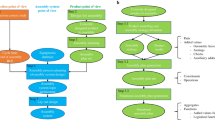Abstract
An integration strategy for assembly sequence planning and sequence scheme evaluation is proposed. This strategy can be used to plan a reasonable assembly sequence, to optimize a sequence scheme, and to predict whether a collision will occur between the assembly tool and assembled components by considering factors like target components and assembly resources.
A hybrid method is presented for assembly sequence modeling that combines human-computer interactive operations to manually build a hierarchical assembly sequence main model and a hybrid graph method to automatically generate sub-assembly sequence schemes of the main model. An optimization algorithm based on time-cost is introduced to handle a best candidate components selection. This relieves the problem of limited capability found when handling large size assembly models with traditional methods. The essential issues involved in system implementation are discussed as well; these include a representation method for the assembly consequence model, an optimization model of assembly sequence planning, and an object-oriented system architecture model employed with multi-agent technology for visually evaluating the assembling process.
This system, KM computer-aided assembly process planning, KMCAAPP, has been developed on the basis of our previous work, KMCAD3; KMCAAPP uses the presented approach. KMCAAPP can be integrated with CAD model from KMCAD3D. A case study shows that the presented approach can use large CAD assembly models and delivers a feasible and effective way to integrate the assembly sequence planning process with scheme evaluation by visually evaluating the assembling process. This allows the identification of design errors in a timely manner and mitigates economic loss.
Similar content being viewed by others
References
Kalpakjian S, Manufacturing process for engineering materials, 2nd ed. Addison-Wesley, Boston
Homen de Mello LS, Sanderson AC (1990) AND/OR graph representation of assembly plans. IEEE Trans Robot Automat 6(2):188–199
Homen de Mello LS, Sanderson AC (1991) A correct and complete algorithm for the generation of mechanical assembly sequence. IEEE Trans Robot Automat 7(2):228–240
Wilson RH, Latombe JC (1994) Geometric reasoning about mechanical assembly. Artifi Intell 71(2):1–31
Liu Y, Popplestone RJ (1989) Planning for assembly from solid models. IEEE International Conference on Robotics and Automation 89 1:222–227, 1989
Ling Z-K (1996) Assembly modeling and sequence planning based on the kinematics of feature. Proc ASME Design Engineering Technical Conferences and Computers in Engineering Conference, August 1996
Li JR, Khoo LP, Tor SB (2002) A novel representation scheme for disassembly sequence planning. Int J Adv Manuf Technol 20:621–630
Hu D, Hu Y, Li C (2002) Mechanical product disassembly sequence and path planning based on knowledge and geometric reasoning. Intl J Adv Manuf Technol 19:688–696
Baker KR (1974) Introduction to sequencing and scheduling. Wiley, New York
Ling Z-K, Zhou XY, Mclean C (1998) Process operators and their roles in integrated assembly process planning. ASME Design Engineering Technical Conference, DETC98/DFM-5753
Dassault Systems (2003) Product introduction of DELMIA of DPM assembly. www.delmia.com, (DPM Assembly Module Introduction)
Holland JH (1975) Adaptation in natural and artificial systems, University of Michigan Press, Ann Arbor, MI
Davis L (1985) Applying adaptive algorithms to epistatic domains. Proc International Joint Conference on Artificial Intelligence, pp 162–164
Goldberg DE (1989) Genetic algorithms in search, optimization and machine Learning. Addison Wesley, Boston, MA
Cavedon L, et al. (eds) (1996) Intelligent agent systems: theoretical and practical issues. Springer, Berlin Heidelberg New York
Zhang C, Lukose D (1996) Multi-agent systems: methodologies and applications. Springer, Berlin Heidelberg New York
Mascle C (2002) Feature-based assembly model for integration in computer-aided assembly. Robot Comput Integr Manuf 18:373–378
Author information
Authors and Affiliations
Corresponding author
Rights and permissions
About this article
Cite this article
Bai, Y., Chen, Z., Bin, H. et al. An effective integration approach toward assembly sequence planning and evaluation. Int J Adv Manuf Technol 27, 96–105 (2005). https://doi.org/10.1007/s00170-004-2155-y
Received:
Accepted:
Published:
Issue Date:
DOI: https://doi.org/10.1007/s00170-004-2155-y




